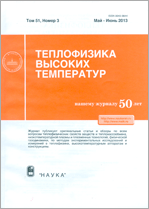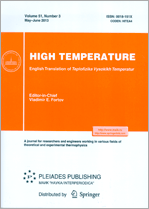|
|
Teplofizika vysokikh temperatur, 2006, Volume 44, Issue 5, Pages 682–692
(Mi tvt1431)
|
 |
|
 |
This article is cited in 16 scientific papers (total in 16 papers)
Thermophysical Properties of Materials
Application of the embedded atom model to liquid metals: Liquid mercury
D. K. Belashchenko
Moscow State Institute of Steel and Alloys (Technological University)
Abstract:
The procedure is suggested for the calculation of the embedded atom potential for a liquid metal, which involves the use of diffraction data on the structure of material in the vicinity of the melting point. The procedure is used for mercury at temperatures from $293$ to $1803$ K. The data on the structure of mercury at $293$ K and the thermodynamic properties of mercury at $293$ and $1673$ K are used in selecting the parameters of embedded atom potential. The calculated critical temperature for mercury is close to the actual value of $\sim1750$ K. The self-diffusion coefficients increase with temperature by the power law. The variation of the structure characteristics of liquid metal with the temperature increasing by several hundred degrees is described correctly. However, at temperatures above $1000$ K, the predicted structure of models differs appreciably from the actual structure. These differences are explained by the dependence of the real potential of interparticle interaction of mercury on density during the metal-nonmetal transition occurring in the case of heating.
Received: 13.09.2005
Citation:
D. K. Belashchenko, “Application of the embedded atom model to liquid metals: Liquid mercury”, TVT, 44:5 (2006), 682–692; High Temperature, 44:5 (2006), 675–686
Linking options:
https://www.mathnet.ru/eng/tvt1431 https://www.mathnet.ru/eng/tvt/v44/i5/p682
|


| Statistics & downloads: |
| Abstract page: | 182 | | Full-text PDF : | 81 |
|





 Contact us:
Contact us: Terms of Use
Terms of Use
 Registration to the website
Registration to the website Logotypes
Logotypes








 Citation in format
Citation in format 
